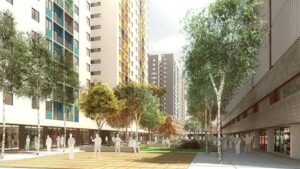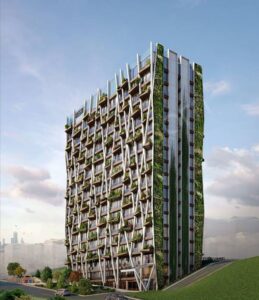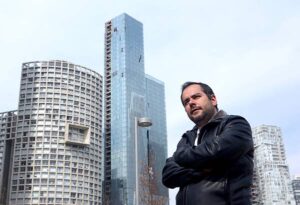Stories
EDGE Experts – The Gurus of Green Building
EDGE Experts provide their insights on the challenges and opportunities of working with clients to design, build, and certify green in their respective markets.

“Let the word spread about EDGE certification and the rest will come,” says EDGE Expert Daniela Corcuera in São Paulo.
Positioning a building in the right direction. Adding flow restrictors to taps. Selecting hollow concrete blocks. Small decisions can have big impacts when it comes to the value of resource-efficient design. How to make the best choices is increasingly being influenced by a new breed of green building advisors called EDGE Experts. They are professionals who guide and educate property developers on EDGE, which is the green building software and certification system of IFC, a member of the World Bank Group.
Less architects than environmental scientists, EDGE Experts provide advice early in the design process to get designs certification-ready. “Through the EDGE software I can provide understanding as to how a building will perform,” says Nandana Kumar, a senior manager for the sustainable design practice of LEAD Consultancy and Engineering Services and an EDGE Expert in Bengaluru. “As soon as the client has a clear picture as to what his energy, water and embodied energy in materials savings will be, he provides the go-ahead signal, as he’s landed in the right place to meet the EDGE standard and move forward with certification.”

EDGE Expert Daniela Corcuera is working with Canopus and the city of São Paulo to restore a declining downtown area with a five-building residential project.
Daniela Corcuera, who is a LEED AP, post-graduate university instructor, and EDGE Expert working at Quanta Studio in São Paulo, says that her clients jump on EDGE once they hear that it’s a program offered by IFC, and that GBCI can be selected as a certifier. “All it takes is to hear these two names,” says Daniela. The added affordability, ease-of-use of the software, and overall lack of complexity in the certification process seal the deal. “EDGE provides great information for architects to identify their green strategies for the best return on investment and utility savings,” she explains. “This can later be used by clients to sell their buildings.” Daniela is currently working with Canopus on the Julio Prestes Complex, a public-private partnership that aims to transform a decaying area of downtown São Paulo into a thriving residential hub.
Dai Nhan Nguyen, an engineer who studied at Ho Chi Minh City’s University of Technology and currently serves as the technical manager for sustainable design at Ardor Architects, was keen on devoting his career to energy saving in buildings when he discovered EDGE. “In one word, EDGE is about ‘assessment,'” says Dai Nhan, who recently helped 4M Joint Stock Company on EDGE-certifying their M-Building Commercial Office Tower. “When I perform calculations in the software to share with clients, they get a reliable picture of the project’s savings based on the decisions they’ve made. I thought about what I could do with EDGE, knowing it could benefit me professionally for what I want to achieve.”

EDGE Expert Katya Kaya was integrally involved in Greenox, an iconic project in Istanbul that is pursuing EDGE certification.
“EDGE opens an important gateway, making it possible for everyone to design and build green,” says Katya Kaya, a project manager for Turkeco Construction and Energy Inc. in Istanbul who is also a BREEAM International Assessor, LEED AP and EDGE Expert. Katya has a background in energy science and technology, and specializes in sustainable materials and environmental product declaration. “We don’t need to use simulation software to model a project, because the capability is built into the free EDGE software,” she says.
David Dominguez, a LEED AP and USGBC/LEED faculty member, CEO of 3Lotus Consulting Mexico and member of SUMe (Mexico’s Green Building Council), quickly saw the potential for EDGE to encourage sustainable development and transform markets. Through EDGE, he’s diversified his services and discovered new and practical ways to improve the performance of his clients’ projects without incurring complexity or significant budget increase. “Now that the interest in green is growing and the business case is understood, clients see that EDGE certification translates to a way to achieve their goals,” says David. “It’s the ideal combination of being able to conserve resources while achieving market distinction.”

EDGE Expert David Dominguez in Mexico City. He estimates that in five to 10 years EDGE will be the most important certification tool for the mass market, leading to a future with more green buildings than conventional buildings.
David has developed a niche for himself as an EDGE Expert for Bancolombia, who offer preferential financing rates for roughly 45% of Colombia’s residential developers through a green bond supported by IFC. Out of 126 potential Bancolombia clients, 30 signed up straight away. “For a huge residential project in Cali, the savings on the loan was $330,000, and the cost of certification was $11,000,” says David. “The profit is 30 times the investment, making it far less expensive to certify with EDGE than not to do it while providing the project with a powerful marketing tool.”
Daniela says that making the EDGE software a “stronghold of knowledge” and its power as a credible international certification system are what will make it popular, as the green building sector is progressing in the right direction. Nandana cites marketability, corporate image and CSR as ample reasons for clients to adopt EDGE.
“I have a strong belief in the future of green buildings,” says Dai Nhan. “EDGE is a powerful tool for architects and engineers, and is the way for the construction sector to move forward. EDGE will make change happen.”

